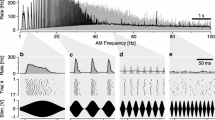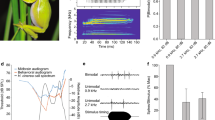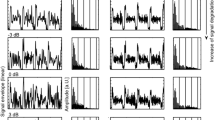Abstract
Acoustic communication is a fundamental component of mate and competitor recognition in a variety of taxa and requires animals to detect and differentiate among acoustic stimuli (Bradbury and Vehrencamp in Principles of animal communication, 2nd edn., Sinauer Associates, Sunderland, 2011). The matched filter hypothesis predicts a correspondence between peripheral auditory tuning of receivers and properties of species-specific acoustic signals, but few studies have assessed this relationship in rodents. We recorded vocalizations and measured auditory brainstem responses (ABRs) in northern grasshopper mice (Onychomys leucogaster), a species that produces long-distance calls to advertise their presence to rivals and potential mates. ABR data indicate the highest sensitivity (28.33 ± 9.07 dB SPL re: 20 μPa) at 10 kHz, roughly corresponding to the fundamental frequency (11.6 ± 0.63 kHz) of long-distance calls produced by conspecifics. However, the frequency range of peripheral auditory sensitivity was broad (8–24 kHz), indicating the potential to detect both the harmonics of conspecific calls and vocalizations of sympatric heterospecifics. Our findings provide support for the matched filter hypothesis extended to include other ecologically relevant stimuli. Our study contributes important baseline information about the sensory ecology of a unique rodent to the study of sound perception.





Similar content being viewed by others
References
Amézquita A, Flechas SV, Lima AP, Gasser H, Hödl W (2011) Acoustic interference and recognition space within a complex assemblage of dendrobatid frogs. Proc Natl Acad Sci USA 108:17058–17063
Bailey V, Sperry CC (1929) Life history and habits of grasshopper mice, genus Onychomys. US Dept of Agr Tech Bull 145:1–19
Barlow HB (1961) The coding of sensory messages. In: Thorpe WH, Zangwill OL (eds) Current problems in animal behavior. Cambridge University Press, Cambridge, pp 331–360
Barth FG (2016) A spiders sense of touch: what to do with myriads of tactile hairs? In: von der Emde G, Warrant E (eds) The ecology of animal senses: matched filters for economical sensing. Springer, New York, pp 27–58
Bennur S, Tsunada J, Cohen YE, Liu RC (2013) Understanding the neurophysiology basis of auditory abilities for social communication: a perspective on the value of ethology paradigms. Hear Res 305:3–9
Blatchley BJ, Cooper WA, Coleman JR (1987) Development of auditory brainstem response to tone pip stimuli in the rat. Dev Brain Res 32:75–84
Bradbury JW, Vehrencamp SL (2011) Principles of animal communication, 2nd edn. Sinauer Associates, Sunderland
Briggs JR, Kalcounis-Rueppell M (2011) Similar acoustic structure and behavioral context of vocalizations produced by male and female California mice in the wild. Anim Behav 82:1263–1273
Capranica RR, Moffat JM (1983) Neurobehavioral correlates of sound communication in anurans. In: Ewert JP, Capranica RR, Ingle DJ (eds) Advances in vertebrate neuroethology. Plenum, London, New York, pp 701–730
Chen J, Jono T, Cui J, Yue X, Tang Y (2016) The acoustic properties of low intensity vocalizations match hearing sensitivity in the webbed-toed gecko, Gekko subpalmatus. PLoS One 11:e0146677
Dent ML, Screven LA, Kobrina A (2018) Hearing in rodents. In: Dent ML, Fay RR, Popper AN (eds) Rodent bioacoustics, vol 67. Springer Handbook of Auditory Research, Cham, pp 71–105
Dooling RJ, Peters SS, Searcy MH (1979) Auditory sensitivity and vocalizations of the field sparrow (Spizella pusilla). Bull Psychon Soc 14:106–108
Endler JA (1993) Some general comments on the evolution and design of animal communication systems. R Soc Philos Trans Biol Sci 340:215–225
Flake LD (1973) Food habits of four species of rodents on a short-grass prairie in Colorado. J Mamm 54:636–647
Frank DH (1989) Spatial organization, social behavior, and mating strategies of the southern grasshopper mouse (Onychomys torridus). Dissertation, Cornell University
Gall M, Wilczynski W (2015) Hearing conspecific vocal signals alerts peripheral auditory sensitivity. Proc R Soc B 282:20150749
Gall M, Brierley LE, Lucas JR (2011) Species and sex effects on auditory processing in brown-headed cowbirds and red-winged blackbirds. Anim Behav 82:973–982
Gall M, Brierley LE, Lucas JR (2012) The sender receiver matching hypothesis: support from the peripheral coding of acoustic features in songbirds. J Exp Biol 215:3742–3751
Gerhardt HC, Huber F (2002) Acoustic communication in insects and anurans. University of Chicago Press, Chicago, London
Gerhardt HC, Schwarz JJ (2001) Auditory tuning and frequency preferences in anurans. In: Ryan MJ (ed) Anuran communication. Smithsonian Institution Press, Washington, pp 73–85
Gerhardt P, Henning Y, Begall S, Malkemper EP (2017) Audiograms of three subterranean rodent species (genus Fukomys) determined by auditory brainstem responses reveal extremely poor high-frequency hearing. J Exp Biol 220:4377–4382
Hafner MS, Hafner DJ (1979) Vocalizations of grasshopper mice (Genus Onychomys). J Mamm 60:85–94
Hall J (2007) New handbook of auditory evoked responses. Pearson Education, Boston
Hanson JL, Hurley LM (2012) Female presence and estrous state influence mouse ultrasonic courtship vocalizations. PLoS One 7:e40782
Heffner HE (1980) Hearing in Glires: domestic rabbit, cotton rat, feral house mouse, and kangaroo rat. J Acoust Soc Am 68:1584–1599
Heffner HE, Heffner RS (1985) Hearing in two cricetid rodents: wood rat (Neotoma floridana) and grasshopper mouse (Onychomys leucogaster). J Comp Psychol 99:275–288
Heffner RS, Heffner HE (1988) Sound localization in a predatory rodent, the northern grasshopper mouse (Onychomys leucogaster). J Comp Psychol 102:66–71
Heffner RS, Heffner HE (1990) Vestigial hearing in a fossorial mammal, the pocket gopher (Geomys bursarius). Hear Res 46:239–252
Heffner RS, Heffner HE (1992) Hearing and sound localization in blind mole rats (Spalax ehrenbergi). Hear Res 62:206–216
Heffner HE, Heffner RS (2003) Audition. In: Davis SF (ed) Handbook of research methods in experimental psychology. Blackwell, Malden, pp 413–444
Henry KS, Lucas JR (2008) Coevolution of auditory sensitivity and temporal resolution with acoustic signal space in three songbirds. Anim Behav 76:1659–1671
Holmstrom LA, Eeuwes LBM, Roberts PD, Portfors CV (2010) Efficient encoding of vocalizations in the auditory midbrain. J Neurosci 30:802–819
Jacobson JT (1985) An overview of the auditory brainstem response. In: Jacobson JT (ed) the auditory brainstem response. College-Hill Press, San Diego, pp 3–12
Kalcounis-Rueppell MC, Metheny JD, Vonhof MJ (2006) Production of ultrasonic vocalization by Peromyscus mice in the wild. Front Zool 3:3
Katbamna B, Thodi C, Senturia JB (1996) Auditory-evoked brainstem responses in the torpid deermouse. Physiol Behav 59:189–194
King J, Insanally M, Jin M, Martins ARO, D’amour JA, Froemke RC (2015) Rodent auditory perception: critical band limitations and plasticity. Neuroscience 296:55–65
Klink KB, Bendig G, Klump GM (2006) Operant methods for mouse psychoacoustics. Behav Res Meth 38:1–7
Kobrina A, Dent ML (2016) The effects of aging and sex on detection of ultrasonic vocalizations by adult CBA/CaJ mice (Mus musculus). Hear Res 341:119–129
Kubke MF, Wild JM (2018) Anatomy of vocal communication and hearing in rodents. In: Dent ML, Fay RR, Popper AN (eds) Rodent bioacoustics, vol 67. Springer Handbook of Auditory Research, Cham, pp 131–164
Land R, Burghard A, Kral A (2016) The contribution of inferior colliculus activity to the auditory brainstem response (ABR) in mice. Hear Res 341:109–118
Lohr B, Dooling RJ (1998) Detection of changes in timbre and harmonicity in complex sounds by zebra finches (Taenipygia undulates) and budgerigars (Melopsittacus undulates). J Comp Psychol 112:36–47
Lucas JR, Velez A, Henry KS (2015) Habitat-related differences in auditory processing of complex tones and vocal signal properties in four songbirds. J Comp Physiol A 201:395–410
Manley GA (1971) Some aspects of the evolution of hearing in vertebrates. Nature 230:506–509
Manley GA (2000) Cochlear mechanisms from a phylogenetic viewpoint. Proc Natl Acad Sci USA 97:11736–11743
McNab BK (1963) Bioenergetics and the determination of home range size. Am Nat 97:133–140
Miller JR, Engstrom MD (2012) Vocal stereotypy in the rodent genera Peromyscus and Onychomys (Neotominae): taxonomic signature and call design. Bioacous 21:193–213
Miranda JA, Shepard KN, McClintock SK, Liu RC (2014) Adult plasticity in the subcortical auditory pathway of the maternal mouse. PLoS One 9:e101630
Moreno-Gómez FN, Sueur J, Soto-Gamboa M, Penna M (2013) Female frog auditory sensitivity, male calls, and background noise: potential influences on the evolution of a peculiar matched filter. Biol J Linn Soc 110:814–827
Naguib M (1995) Auditory distance assessment of singing conspecifics in Carolina wrens: the role of reverberation and frequency-dependent attenuation. Anim Behav 50:1297–1307
Naguib M (1997) Use of song amplitude for ranging in Carolina wrens, Thryothorus ludvicianus. Ethol 103:723–731
Neilans E, Holfoth D, Radziwon K, Portfors C, Dent M (2014) Discrimination of ultrasonic vocalizations by CBA/CaJ mice (Mus musculus) is related to spectrotemporal dissimilarity of vocalizations. PloS One 9:e85405
Nelson BS (2000) Avian dependence on sound pressure level as an auditory distance cue. Anim Behav 59:57–67
Ohlemiller KK, Dahl AR, Gagnon PM (2010) Divergent aging characteristics n CBA/J and CBA/CaJ mouse cochlea. J Assoc Res Otolaryngol 11:605–623
Pasch B, Bolker BM, Phelps SM (2013) Interspecific dominance via vocal interactions mediates altitudinal zonation in Neotropical singing mice. Am Nat 182:E161–E173
Pasch B, Abbasi MZ, Wilson M, Zhao D, Searle JB, Webster MS, Rice AN (2016) Cross-fostering alters advertisement vocalizations of grasshopper mice (Onychomys): evidence for the developmental stress hypothesis. Physiol Behav 157:265–269
Pasch B, Tokuda IT, Riede T (2017) Grasshopper mice employ distinct sound production mechanisms in different social contexts. Proc R Soc B 284:20171158
Peters S, Derryberry EP, Nowicki S (2012) Songbirds learn songs least degraded by environmental transmission. Biol Lett 8:736–739
Pinheiro J, Bates D, DebRoy S, Sarkar D, R Core Team (2017) nlme: Linear and Nonlinear Mixed Effects Models. R package version 3.1-131
Pinter AJ (1971) Hybridization between two species of grasshopper mice (Onychomys) in the laboratory. J Mamm 52:573–582
Portfors CV (2007) Types and functions of ultrasonic vocalizations in laboratory rats and mice. J Am Assoc Lab Anim Sci 46:28–34
Portfors CV (2018) Processing of ultrasonic vocalizations in the auditory midbrain of mice. In: Brudzynski SM (ed) Handbook of ultrasonic vocalization: a window into the emotional brain (Vol 25). Elsevier, Amsterdam, pp 73–82
Portfors CV, Roberts PD (2014) Mismatch of structural and functional tonotopy for natal sounds in the auditory midbrain. Neuroscience 258:192–203
Portfors CV, Mayko ZM, Jonson K, Cha GF, Roberts PD (2011) Spatial organization of receptive fields in the auditory midbrain of awake mouse. Neuroscience 193:429–439
R Core Team (2017) R: a language and environment for statistical computing. R Foundation for Statistical Computing, Vienna, Austria. https://www.R-project.org/
Ralls K (1967) Auditory sensitivity in mice: Peromyscus and Mus musculus. Anim Behav 15:123–128
Ruebhausen MR, Brozoski TJ, Bauer CA (2012) A comparison of the effects of isoflurane and ketamine anesthesia on auditory brainstem response (ABR) thresholds in rats. Hear Res 287:25–29
Ruffer DG (1966) Observations on the calls of the grasshopper mouse (Onychomys leucogaster). Ohio J Sci 66:219–220
Ruffer DG (1968) Agonistic behavior of the northern grasshopper mouse (Onychomys leucogaster breviauritus). J Mamm 49:481–487
Ryan MJ, Rand AS (1993) Species recognition and sexual selection as a unitary problem in animal communication. Am Nat 47:647–657
Ryan MJ, Perril SA, Wilczynski W (1992) Auditory tuning and call frequency predict population-based mating preferences in the cricket frog, Acris crepitans. Am Nat 139:1370–1383
Schuchmann M, Siemers BM (2010) Behavioral evidence for community-wide species discrimination from echolocation calls in bats. Am Nat 176:72–82
Sikes RS, Animal Care and Use Committee of the American Society of Mammalogists (2016) 2016 Guidelines of the American Society of Mammalogists for the use of wild mammals in research and education. J Mamm 97:663–688
Simmons AM (2013) ‘‘To ear is human, to frogive is divine’’: Bob Capranica’s legacy to auditory neuroethology. J Comp Phys A 199:169–182
Stapp P (1999) Size and habitat characteristics of home ranges of northern grasshopper mice (Onychomys leucogaster). Southwest Assoc Nat 44:101–105
Vélez A, Gall MD, Fu J, Lucas JR (2015) Song structure, not high-frequency song content, determines high-frequency auditory sensitivity in nine species of New World sparrows (Passeriformes: Emberizidae). Funct Ecol 29:487–497
Von der Emde G, Ruhl T (2016) Matched filtering in African weakly electric fish: two senses with complementary filters. In: Von der Emde G, Warrant E (eds) The ecology of animal senses: matched filters for economical sensing. Springer, New York, pp 237–264
Von der Emde G, Warrant E (2016) The ecology of animal senses: matched filters for economical sensing. Springer, New York
von Uexküll J (1934) A stroll through the worlds of animals and men. In: Schiller CH (ed) Instinctive behavior. International University Press, New York, pp 5–80
Warrant EJ (2016) Matched filtering and the ecology of vision in insects. In: Von der Emde G, Warrant E (eds) The ecology of animal senses: matched filters for economical sensing. Springer, New York, pp 143–168
Webster DB, Webster M (1972) Kangaroo rat auditory thresholds before and after middle ear reduction. Brain Behav Evol 5:41–53
Wehner R (1987) Matched filters—neural models of the external world. J Comp Physiol A 161:511–531
Wilczynski W, Rand AS, Ryan MJ (2001) Evolution of calls and auditory tuning in the Physalaemus pustulosus species group. Brain Behav Evol 58:137–151
Wiley RH, Richards DG (1978) Physical constraints on acoustic communication in the atmosphere: implications for the evolution of animal vocalizations. Behav Ecol Sociobiol 3:69–94
Willott JF (2006) Measurement of the auditory brainstem response (ABR) to study auditory sensitivity in mice. Curr Protoc Neurosci 34(1):8.21B.1–8.21B.12. https://doi.org/10.1002/0471142301.ns0821bs34
Woolley SMN, Portfors CV (2013) Conserved mechanisms of vocalization coding in mammalian and songbird auditory midbrain. Hear Res 305:45–56
Zhao L, Wang J, Yang Y, Zhu B, Brauth SE, Tang Y, Cui J (2017) An exception to the matched filter hypothesis: a mismatch of male call frequency and female best hearing frequency in a torrent frog. Ecol Evol 7:419–428
Zhou X, Jen PH, Seburn KL, Frankel WN, Zheng QY (2006) Auditory brainstem response in 10 inbred strains of mice. Brain Res 1091:16–26
Zhu B, Wang J, Brauth SE, Tang Y, Cui J (2016) The spectral structure of vocalizations match hearing sensitivity but imprecisely in Philautus odontotarsus. Bioacoustics 26:121–134
Acknowledgements
We thank Dr. Scott Nichols for his veterinary assistance and Madeline Bloomquist, Grace Griffiths, and Nathaniel Mull for their assistance with maintaining the mouse colony.
Funding
This study was funded by the E.O. Wilson Conservation award from the Animal Behavior Society (DG), Northern Arizona University (DG; BP), and the National Science Foundation- IOS # 1755429 (BP).
Author information
Authors and Affiliations
Corresponding author
Ethics declarations
Conflict of Interest
The authors declare that they have no conflict of interest.
Ethical approval
All procedures performed in studies involving animals were in accordance with the ethical standards and approval of the Institutional Animal Care and Use Committee at Northern Arizona University (#15-014 and #16-001) and guidelines of the American Society of Mammalogists (Sikes et al. 2016). Founder animals were captured with a permit from the New Mexico Department of Game and Fish (# 3562).
Additional information
Publisher's Note
Springer Nature remains neutral with regard to jurisdictional claims in published maps and institutional affiliations.
Electronic supplementary material
Below is the link to the electronic supplementary material.
359_2019_1338_MOESM1_ESM.eps
Fig. S1 Auditory brainstem response (ABR) of an individual northern grasshopper mouse in response to a 0.1 ms mono-phasic click stimulus presented at a rate of 21 presentations/second. I, II, and III refer to ABR waveforms
Rights and permissions
About this article
Cite this article
Green, D.M., Scolman, T., Guthrie, O.W. et al. A broad filter between call frequency and peripheral auditory sensitivity in northern grasshopper mice (Onychomys leucogaster). J Comp Physiol A 205, 481–489 (2019). https://doi.org/10.1007/s00359-019-01338-0
Received:
Revised:
Accepted:
Published:
Issue Date:
DOI: https://doi.org/10.1007/s00359-019-01338-0




